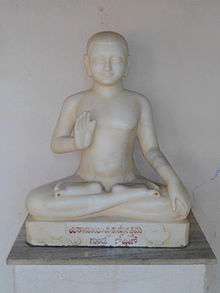Jinasena
| Acharya Shri Jinasena | |
|---|---|
| जिनसेन | |
 Image of a Digambara Acharya | |
| Religion | Jainism |
| Sect | Digambara |
| Personal | |
| Born | 783 AD |
| Died | 838 AD |
| Religious career | |
| Predecessor | Virasena |
| Disciple(s) | Amoghavarsha |
| Initiation | by Virasena |
| Part of a series on |
| Jainism |
|---|
 |
|
Jain prayers |
|
Ethics |
|
Major sects |
|
Festivals |
|
|
Jinasena (8th century CE) was one of the several famous Digambara Acharya (head of a monastic order). He was the author of famous Adipurana and Mahapurana. He was the disciple of Acharya Virasena and he completed his teacher's famous commentary Dhavala on Ṣaṭkhaṅḍāgama (Vikram 894, 837 CE), the most revered text in the Digambara tradition. The name is shared by an earlier Acharya Jinasena who was the author of Harivamsa Purana in Saka 705 (Vikram 840, 783 AD)[1]
Life
Acharya Jinasena belonged to the Panchastupanvaya and was a disciple of Virasena.[2]
Works
He wrote the encyclopediaic Adipurana.[3] Mahapurana includes Ādi purāṇa[4] and Uttarapurana, the project was completed by his pupil Gunabhadra.[5]
Mahapurana is the source of the famous quote, quoted by Carl Sagan and many others:[6][7]
Some foolish men declare that Creator made the world. The doctrine that the world was created is ill-advised, and should be rejected. If god created the world, where was he before creation? If you say he was transcendent then, and needed no support, where is he now?
No single being had the skill to make the world - for how can an immaterial god create that which is material? How could god have made the world without any raw material? If you say he made this first, and then the world, you are face with an endless regression. If you declare that the raw material arose naturally you fall into another fallacy, for the whole universe might thus have been its own creator, and have risen equally naturally. If god created the world by an act of will, without any raw material, then it is just his will made nothing else and who will believe this silly stuff?
If he is ever perfect, and complete, how could the will to create have arisen in him? If, on the other hand, he is not perfect, he could no more create the universe than a potter could. If he is formless, actionless, and all-embracing, how could he have created the world? Such a soul, devoid of all modality, would have no desire to create anything. If you say that he created to no purpose, because it was his nature to do so then god is pointless.
If he created in some kind of sport, it was the sport of a foolish child, leading to trouble. If he created out of love for living things and need of them he made the world; why did he not make creation wholly blissful, free from misfortune? Thus the doctrine that the world was created by god makes no sense at all.
[from Barbara Sproul, Primal Myths (San Francisco; Harper Row, 1979].
See also
References
Citations
- ↑ Jinasena, Acharya; Jain (Sahityacharya), Dr. Pannalal (2008) [783 AD], Harivamsapurana [Harivamsapurana], Bhartiya Jnanpith (18, Institutional Area, Lodhi Road, New Delhi - 110003), ISBN 978-81-263-1548-2
- ↑ Jain Dharma ka_Maulik Itihas_Part 3, Ed. Gajsingh Rathod, 2000, jain Itishas Samiti, p. 652-656
- ↑ Narasimhacharya 1988, p. 2.
- ↑ Granoff 1993, p. 208.
- ↑ Voices of Unbelief: Documents from Atheists and Agnostics, Dale McGowan, ABC-CLIO, 2012, p. 23
- ↑ Sources of Indian Tradition, Ainslie T. Embree, Columbia University Press, 1958, p. 77
- ↑ "The Edge of Forever," of "Cosmos," by Carl Sagan, epigraph to chapter 10, 1980, p. 140
Sources
- Granoff, Phyllis (1993) [1990], The Clever Adulteress and Other Stories: A Treasury of Jaina Literature, Motilal Banarsidass, ISBN 81-208-1150-X
- Nakamura, Hajime (1983), A History of Early Vedānta Philosophy, 2 (First ed.), Motilal Banarsidass, ISBN 0-89581-956-2
- Narasimhacharya, Ramanujapuram (1988), History of Kannada Literature (Readership Lectures), Asian Educational Services, ISBN 81-206-0303-6
- Sen, Sailendra Nath (1999) [1988], Ancient Indian History and Civilization (Second ed.), New Age International Publishers, ISBN 81-224-1198-3
External links
